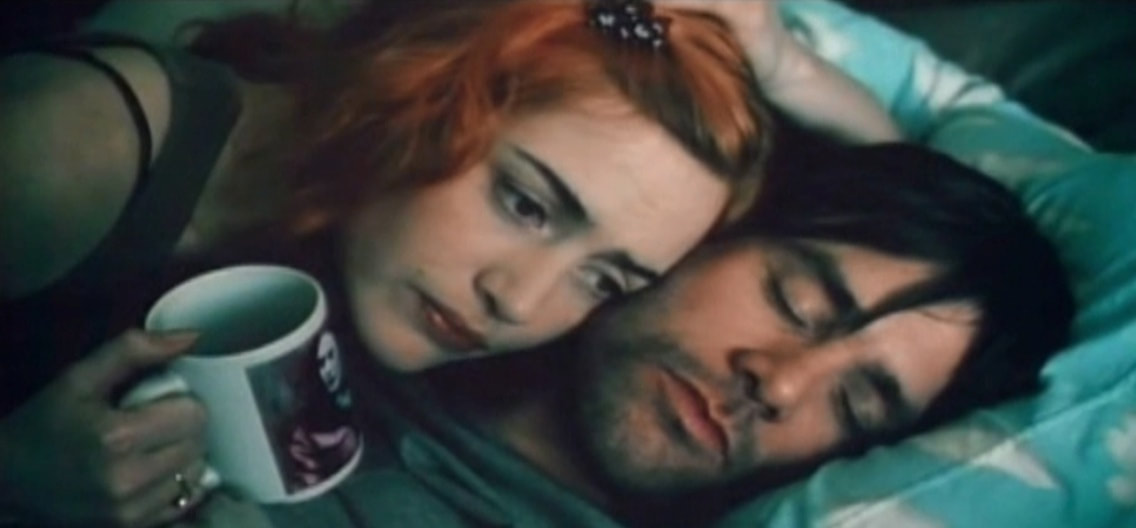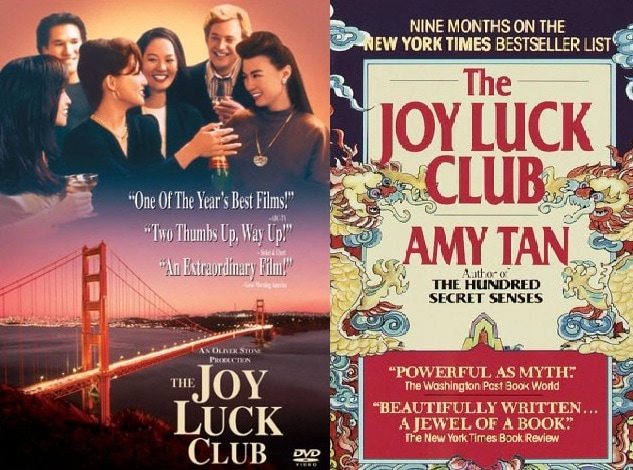Fig 1 .Clementine played by Winslet wears a T-shirt that says “love is…” hinting the curious bondage that cannot separate the two even with a memory erasure going on. Focus Features The pictorial art The pictorial art of Eternal Sunshine of a Spotless Mind is a mindful one. From Clementine’s hair to the souvenirs of Clementine that Joel later collects to takes to the Lacuna Clinic, details are depicted and closely associated to one another like motifs and symbols that draw clues to the plot, waiting for the spectator’s observable eye to unwrap. Such as in the scene of Clementine’s confession toward Joel while he is half awake. Clementine holds a mug with her picture print, in the picture she is in orange hair, which is Joel’s best image of her. He calls her “Tangerine” their secretive nickname, which is later used by his Counterfeiter. The picture on the mug is like“ a picture within the picture “ in this frame. As if another piece of time is etched into the present narrative. “ a picture within the picture “ Fig2. Focus Features The orange color of her hair is a smooth and comfortable contrast with orange’s complementary color, a blue pillow as a base in the frame. Carrey wears a dark green shirt complementary to the reddish shades of Winslet’s orange hair. The frame looks like a harmonious idyllic evening nap and they look like idea lovers. Although, quickly the visual frame dims in a darker light before the fade out dissolve transition, when Joel defends of his closure by suggesting that Clementine’s talkativeness is rather of annoyance, leaving Clementine agitated. The pictorial art here resembles theatrical features such as dramatic use of light and shadow, dimming contours, areas leaving spotlight in the middle focus. The visual effect is similar of the technique “Tenebrism” commonly seen in rembrandt’s oil painting style, used in works such as “The Night Watch”. The most classical of the movies cinematic visuals in Eternal Sunshine of the Spotless Mind is the high angle shot of the scene where Clementine takes Joel to the "frozen Charles", a frozen lake near the suburbs. Clementine suggests that they lie down, while Joel stay’s hesitant and suspicious that the ice is going to break. He lies down with her anyways, surprisingly finding himself in his happiest, as later is revealed in his diary excerpt, and in his subconscious confessing it to Clementine. The shot taken with the couples lying near a fracture of ice has been highly discussed. Whether intentional designed or randomly shot, the scene is a masterpiece a.k.a mastermind of the director’s projection. On the movie poster of Eternal Sunshine of the Spotless Mind, the crack on the frozen Charles appears to be a crack on the mind of Jim Carrey. Fig 3. Clementine and Joel lying on the "frozen Charles".
Joel: I could die right now, Clem. I'm just... happy. I've never felt that before. I'm just exactly where I want to be. Focus Features The audiovisual art In the first beginning of the movie, where Joel meets Clementine in the train station of Montauk, Clementine tries to start a conversation with Joel. A playful background music foliates Clementine’s blooming voice, the music wit fully hints Clementine’s characteristics and foreplays the mingling effect of chemistry between the two protagonists with a playful style. By elements of the sound, the music composer flawlessly lures the spectators into the plot and character; we are driven into the mindsets and mind map of Joel Barish; his anguish, his restlessness and his suspense; we comprehend the anger and hurt of Clementine, and taste the joyfulness of their happy love life. In terms of audiovisual art, the movies soundtrack impeccably empowers the visual storyline enhancing sentimental emotions along the way, as we feel the gradually increasing intensity of melancholy, and of Joel’s inner mind conflict of holding on to the memory of Clementine, whilst enduring the treatment of erasing the memories of heartbreak. Joel’s psychological thrill and fear resonances throughout the movies sound effects. We watch him desperately hide memories of Clementine into the resistant territories of the mind map such as shame (humiliation) and horror. Done by Jon Brion, Best Score Soundtrack Album Grammy nominee for 1999’s ”Magnolia”, Jon Brion receives another nomination for “Eternal Sunshine of the spotless mind”, which is well accredited. The music scores are seamlessly well-designed, even the movies theme song "Everybody's Got to Learn Sometime" (The Korgis cover done by artist Beck) associates to the cinematic visuals as we recall, in the beginning of the film when the title appears, Joel is crying are driving in his car listening to "Everybody's Got to Learn Sometime", before he ejects the tape and throws it out the window. As the film comes to an end when the film credits starts to display, we hear the song again. The song creates a beautiful melancholy, leaving viewers lingering in emotions of the unfathomable force of love that makes two fault-finding lovers want to start again. The power of theme songs is one of the forces in movie that cannot be undermined. It’s a component that brings out emotion from another space, if well selected and designed. Repetition of sound and lines deem compatible to the surrealism form of visual display, and is notable and well composed in this film. Nevertheless, the Cherry on the top, is it’s theme song "Everybody's Got to Learn Sometime" which is all other else that is unexplained yet informative in emotion and understanding. You can not not love the eternal sunshine on the spotless mind...
0 評論
In the stride of Globalization, acculturation and Enculturation has become non unfamiliar,
but actually a necessity, a social phenomenon that is slowly penetrating the present state of social communication structure, in terms of business communication, social education, nonetheless- the family relationship. In this film, The Joy Luck Club, based on the novel by Amy Tan. The author uses her personal experience as the keel of the storyline, giving life to the characters and plot of the scene, vividly interpreting the lives of a pioneer generation of Chinese immigrants and their second generation. Here their second generations, children that have never had a glance of their home China, but nourished with American milk and school books after their birth, have no sense of Chinese culture. Thus after their detachment from the mother bodies umbilical cord, the only infiltration of cultural blood in their heritage, comes only from their mom. Although these Chinese Asian American girls conflict with their mothers up-bring, even after they have matured as mothers of their own children, this continuous strangle of conflict still remains.... Culture itself, is a continuous development and state of learning, understanding the culture schema will take a lifelong learning process. A process that never stops, till the day we depart from this world. And till that day, the world will keep coming to us, therefore there is no stopping in cultural learning and acculturation. This novel written in 1989, following the movie in 1993, was a phenomenon, since it was an era of immigration, and immigration was only beginning to prosper due to the reviving economics of the United States. But until today, after, with evidence to Amy Chou’s “Battle Hymn of The Tiger Mom” (published in 2011), a confession of Chua, as an autobiographic way of illustrating her experiences and efforts of applying what she describes as a traditional, strict “Chinese” upbringing educating her own girls. I enjoyed Amy Chou's novel very much, due to it's bald honesty and truthfulness,and how she vividly displays her mind-set, while some still traditional Chinese parents, feel guilt of confessing it. In the joy luck club, the plot focuses on 4 sets of family, each of the Chinese mothers come from a tragic past in China. Suyuan Wu a refugee from the Japanese invasion in China, is forced to leave behind her twin babies in China, after escaping to the USA, she lives in uncertainty of unknowing the babies dealth or well-being. Lindo Jong, a women that has married at an young age to an unmature man, by the words of a matchmaker, determined to escape this unfortunate situation, managed a clever plan releasing herself from this marriage, later fleddingto America. Ying-Ying, one of the four women, marries a charismatic man named Lin Xiao at an young age, just to find out her husband is revealed to be a womanizer and has an abusive characteristic. In an extreme mental state, she accidentally drown her baby, and is heart-broken. In anguish she leaves the country later marrying another man in America. These 4 women all finding hope in this new destination, leaving their past behind. Opening the psychological effects of the a person’s Johari window, we learned that when a person finds hope in a whole new country or environment. Entering a new country makes the self- healing process begin, allowing those hidden parts and Open parts rearrange. Thus later, these four women created “the Joy Luck Club ”, which is a act of triumph and rejoice, celebrating their bondage of rebirth in this new country. We see these four independent women, and their daughters going through the process of acculturation and enculturation, facing conflict in Values and attitudes . As Jandt,F.E (2004) has said, No immigration, as long as livelihood needs are to be met in a new country, can escape acculturation. “Acculturation has four dimensions: integration, Separation, assimilation and deculturation. When a minority moves into a majority culture, he or she will chose one of these modes either consciously or subconsciously” Though the movie has not illustrated too much personal inner-depth-voices of the mother’s philosophy and life reflections. In the novel, Lindo confesses of regret over losing some of her Chinese identity by living so long in America (she is treated like a tourist on a visit to China), as evidence to integration ; however, she expresses concern that Waverly's American upbringing has formed a barrier between them, destruction the mother-daughter relationship. Revealing how an Integration and assimilation acculturation can conflict in communication. These mother bring forth their old fashion values from China, yet their daughters, enculturated in the western surroundings, possess American souls and mindsets inside. Thus the conflict in communication cannot be avoided, simulating the mode of intercultural communication. Since culture is a code we learn and share, and learning and sharing requires communication, Alfred G Smith (1966) says, this conflict is inevitable for relationship development in intimate family relationships. There are several traces in the movie, where we can see the mother’s evidence of integration in forming acculturation, such as one scene where An-Mei Hsu questions her daughter about buying grocery: An-Mei: Who’s coming to dinner? Daughter (Rose): well, Ted is coming over, we’re having sort of a meeting… An-Mei Hsu: meeting? Flour, egg, bitter sweet Hersey bar, Skippy chunky, Sounds like Chocolate peanut butter pie! An-Mei is integrated in western logic of cuisines, and knows that a chocolate peanut butter pie is not linked to a meeting taboo dish, but something more.. Although acculturation increases the interconnectedness of cultures, differences are sources of potential problems (Chaney L.H, Martin ,2007) Harvey (1985) said that Family and personal issues can be disruptive to acculturation. In the Joy Luck Club however, we can see the opposite, how acculturation affects and disrupts the mother-daughter relationship. Since the childhood of their daughters, Suyuan Wu and Lindo Jong, though good friend, compete on their daughters behalf, turningJune and Waverly into childhood rivals, the 2 women each consider their daughter June (daughter of Suyan Wu) & Waverly (Daughter of Lindo) as being more superior than the other in their talents, Therefore, dominantly forcing traditional, strict child-rearing on their daughters. But unlike traditional Chinese children who are obedient in everything the parents say. June who decides not to take up piano playing anymore after an embarrassing recital scene, is forced by her mother physically to sit in front of the piano to practice again, leading to her explode of rebel. Here June expresses her individualistic statement of feeling and choice. We see the western individualism spirit in her words of rebel, as oppose to her mother’s traditional collectivism notion, that “only an obedient daughter stays under this roof”. The same situation of how acculturation disrupts the mother-daughter relationship, in terms of education, happens also in Lindo Jong’s household. Her daughter Waverly is a gifted child chess champion. After a champion quest, Waverly’s photo is featured on the cover of Life magazine. Feeling proud of her daughter, Lindo holds the magazine high upon her chest and tells everyone she meets on the street that, her daughter is the covergirl, Waverly is embarrassed as she walks by her mother’s side. Annoyed at her mother’s action, Waverly angrily fights back, expressing how she doesn’t like her mother using her accomplishments to show off. Her mother assumes her daughter is ashamed of her. They have a fight on the street, where later when Waverly comes home , her mother does not say much and remains silent against her fight in a high-context communication. There are distinctive cultural differences in the eastern and western component. Western cultures such as Americans mostly communicate in a more low-context dialogue, while Asians especially the Chinese communicate in a high-context communication. Such as a period of silence, not revealing their thoughts, allowing imagination and assumption of the counterpart, thus leaving space for conflict in the process of encoding and decoding messages. A similar scene of conflict in encoding and decoding messages happens when Waverly has casually promises her mother a trip to the beauty parlor before Waverly’s wedding, while her mother possessing a traditional value of keeping a great extent of respect to a promise made with their mothers, thinks Waverly would remember the trip to the beauty parlor: Mother(Lindo)(picks up the phone): Waverly! You at the beauty parlor already? Waverly: No Ma. I have a headache. Mother: So you can’t keep promise to your own mother? So you don’t want to go? … Her mother encodes the message with her own assumptions, analyzing it in a Chinese logic of value, to value their elders words. While Waverly’s statement of “No Ma, I have a headache” may mean:”So I didn’t remember our date” or “So I’ll be late for the parlor. ” Her mother interprets it into the meaning that her daughter is not going with her, or that she is breaking the promise they made. There are two plots in the movie, covering the issue of cross-culture marriage. One is the American-Chinese marriage of Waverly and Rich. The dinner scene of Rich coming over to Waverly’s Chinese household for the first time, illustrates the dinning matters between both cultures, differences that if not minded causes impoliteness, such as do not take too much food from the same dish, when everyone has not had their first helping. But Rich does not realize he is conflicting with the cultural invisible rules, and takes an abundant amount for himself. In the western way, it may be a bold way of expressing ”I like this food. ”but it is embarrassing and impolite for Waverly and Waverly’s mother (Lindo). So Lindo sarcastically says to Waverly “He has good appetite”, which is a multilevel message expressed in a high context dialogue, meaning “Rich is healthy, and can eat a lot”(in the Chinese concept), but also ostensibly describing his behavior of helping himself to too much. Lindo’s Xenophobic characteristic towards Rich, inclination of an Asian parent to do so, can be seen in scenes such as when Waverly confesses how she married a Chinese guy just to please her mother, though later ending in divorce. And in the scene where she shows Lindo the fur coat gift Rich has given to her as a gift. Lindo harshly criticizes the gift, saying how the gift does not fit to be the best for her, reflection how Lindo wants the best for her daughter, but also slight evidence of xenophobicism towards this white son-in-law. In Rose and Ted’s case, Rose falls in love with Ted, an American that withholds a prestige social status. Rose meets Ted’s parents for the first time, and has a not so friendly conversation with Ted’s mother, she nurses a racism towards Rose when she tells Rose that she will not be accepted by their families status acquaintances, and describes in stereotype towards Rose how “Vietnam was not so popular”. In comparison of these two mother-in-laws we can see Ted’s mother, an American, being more aggressive and communicating directly in the low-context style. While Lindo, Waverly’s mother, is more implicit towards expressing towards Rich her true feeling (High context communication), and holding the Chinese concept of “Face” does not want to embarrass Rich in front of the table. Leaving Rich unaware of his mother-in-laws true feelings. Cultural synergy is the future competence of enterprises in terms of expanding, therefore, nourishing a more alert sense to culture, and willingness to adjust one’s cultural schema is inevitable. Learning to analyzing different situations of cultural communication, can later be applied to analyzing organization behaviors. Cultural learning is a not just a scholarly humanistic subject, it's a soft skill competence that can be nourished and applied to Human resource managing. |
|





